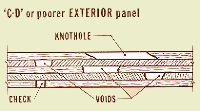Cheaper Grades of Plywood?


We regret that some suppliers of epoxy products are misinforming amateur boat builders, giving the impression that epoxy products are a remedy for all ills. Sometimes the statements sound like the old "medicine men" of the past. For example, we've seen one supplier state, "lf exterior plywood is given the required two coats on all surfaces, it renders that plywood acceptable for all boatbuilding and exterior projects. . . . visible minor voids. . . . . can easily be filled".
We've had many prospective builders of our designs question our naval architects citing this or similar statements. In almost all cases, these builders got the impression that by slopping some of this supplier's products onto inferior grade (but readily available) plywood panels (such as "C", "D", "interior", or even "shop" grades) the panel would somehow be brought up to a marine grade quality. Nothing could be farther from the truth, and such statements are dangerous to say the least. Here's why.
First, while there is probably no difference in the waterproof glues used between the typical "exterior" grade and the higher-priced "marine" grade panel, there definitely is a difference in the quality and perhaps the type of wood used in the inner cores. The marine grade panel is made with inner cores free of voids (often of solid core construction), and of the same lumber as the faces. The face veneers of the marine panel are usually of "A" or sometimes a "B" grade so that there are no exposed knot holes or other defects which could weaken the panel. This high-quality void-free panel offers predictable engineering qualities, fracture-free installation when bending in place over properly designed contours, and will not fail under stress due to voids.
Conversely, the exterior grade panel, while often used in place of the marine grade panel due to cost, may contain voids in the inner cores not visible to the eye. Such voids can be large and end up in areas of the hull subjected to high stress when used for planking. Furthermore, the wood types used for the inner cores can differ from the outer veneers, perhaps being of an inferior wood from a strength and durability standpoint.
Exterior grade panels with face veneers of "C" or lesser grades, such as "D" or shop grade, may be full of knots, unpatched knot holes, checks, splits, and other defects, not to mention even greater inferiority in the inner cores.
While it is possible that all visible voids, such as those on the outer surfaces, could be filled with epoxy, this would not strengthen the panel other than to stiffen it a bit. But what about the voids in the inner plies which are equally important to panel strength when subjected to stress? Since they are probably not even visible, how can they be filled with epoxy? And even if they could be filled all epoxies are weak in tensile strength (although high in compressive strength; and thus could never approach the strength provided by the wood fibers that are missing due to invisible voids.
Our recommendation for planking is, that while exterior grades may be used in straighter areas of a hull if of "A" or "B" face grades, the marine grade panel is always preferred, especially where bending will be necessary. We feel that plywood panels of lesser grades should not be used for structural applications, although they can sometimes be used in non-structural or less-critical applications. No amount of epoxy can change an exterior grade panel into one of marine grade.
lt should be emphasized that the GLEN-L Epoxy Encapsulation System is designed to make an already good material (wood and plywood) a better composite engineering material; not a way to promote the use of inferior materials in the hope of selling some epoxy.